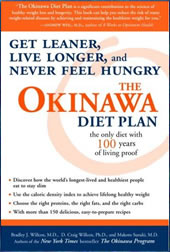Okinawa Diet
 The Okinawa Diet Plan is based on the eating patterns of a group of elderly inhabitants of Okinawa, which is a collection of over a hundred islands off the coast of Japan.
The Okinawa Diet Plan is based on the eating patterns of a group of elderly inhabitants of Okinawa, which is a collection of over a hundred islands off the coast of Japan.
These people are reported to have some of the world’s longest life spans and best health.
Studies show that Okinawans who eat a traditional diet do not gain weight as they age and in addition their rates of heart disease are 80% less and of cancer are 50% less than Americans.
The Okinawa Diet Plan promises dieters that they will become leaner, live longer and never feel hungry by following the ten dietary principles of the Okinawan people. It may even help to reduce wrinkles due to the high antioxidant content of the diet.
The Okinawa Diet Basics
The diet plan is based on four groups of foods that are categorized according to their caloric density:
- Featherweights e.g. green tea and asparagus
- Lightweights e.g. fish and brown rice
- Middleweights e.g. hummus and lean red meat
- Heavyweights e.g. fried foods and desserts
The concept of the diet plan is on limiting calorie intake by emphasizing high volume, high nutrient foods with a low caloric density so the featherweight and lightweight foods will make up the majority of the diet.
It is important to restrict the tendency to overeat as occurs in Western diets. One of the major principles of the Okinawan approach to eating is to only eat until 80% full. If after 10-20 minutes you are still feeling hungry it is acceptable to eat more of the recommended foods if desired.
Okinawans eat on average 500 calories less per day than other social groups however the diet is not simply about calorie restriction but also emphasizes the selection of highly nutritious foods. The recommended foods are low in calories but high in flavor and nutrients. Low glycemic carbohydrates are included and these sustain energy and help keep dieters feeling full until the next meal.
Calorie restriction is a major key to increasing longevity however the authors state that this does not necessarily mean that dieters have to go hungry. Dieters are assisted to gradually phase into the Okinawan style of eating with an eight-week plan.
This is designed to limit the feelings of frustration and deprivation that may occur when attempting to change eating habits too quickly and dramatically.
Recommended Foods
Broth based soups such as miso soup are eaten before each meal so as to reduce the tendency to overeat.
Sweet potato is a staple food and is recommended for its high content of antioxidants.
Other foods that are particularly recommended include green vegetables, edible seaweed, tofu, fish, brown rice and green tea.
Sample Diet Plan
| Breakfast
Okinawan blueberry pancakes |
| Morning Snack
Apple |
| Lunch
Sweet and sour mustard baked tofu |
| Afternoon Snack
Raw vegetable crudités |
| Dinner
Miso soup |
Costs and Expenses
The Okinawa Diet Plan book retails at $14.95.
Pros
- Calorie restriction with optimal nutrition is associated with increased longevity.
- May reduce the risk of diseases commonly associated with obesity and aging.
- Includes a balance of all food groups with low glycemic carbohydrates, essential fats and lean proteins.
- Provides ten servings of vegetables and two servings of fruit daily.
- Vegetarian and vegan options are provided.
- Based on credible scientific research.
- Can be sustained as a lifestyle eating plan.
- Includes 160 recipes that provide both traditional Japanese and Western options.
Cons
- May be easy for dieters to overlook the psychosocial factors in the Okinawan lifestyle that probably play an important role in the enhanced health and longevity of Okinawans.
- Does not address the importance of exercise in a weight loss plan.
- Some of the recipes will not appeal to Western tastes.
- May require a quite dramatic dietary overhaul, as many foods are restricted or severely limited such as breads, dairy products and desserts.
Conclusions
The Okinawa Diet plan fails to adequately address the complete array of lifestyle factors that may be involved in the exceptional health and longevity of the Okinawan people such as physical activity, a sense of community, and general ways of coping with stress.
Nonetheless, this is a highly nutritious eating plan that will provide dieters with the knowledge necessary in order to reduce calories without sacrificing their nutritional intake.
-
Citations:
- Willcox, B. J., Willcox, D. C., & Suzuki, M. A. K. O. T. O. (2004). The Okinawa diet plan. New York, NY: Clarkson N Potter Publishers.
- Colman, R. J., Beasley, T. M., Kemnitz, J. W., Johnson, S. C., Weindruch, R., & Anderson, R. M. (2014). Caloric restriction reduces age-related and all-cause mortality in rhesus monkeys. Nature communications, 5. link
- Willcox, D. Craig, et al. “Caloric restriction and human longevity: what can we learn from the Okinawans?.” Biogerontology 7.3 (2006): 173-177. link
- Cockerham, W. C., & Yamori, Y. (2001). Okinawa: an exception to the social gradient of life expectancy in Japan. Asia Pacific journal of clinical nutrition, 10(2), 154-158. link
- Sho, H. (2001). History and characteristics of Okinawan longevity food. Asia Pacific journal of clinical nutrition, 10(2), 159-164. link
there’s also an online version, where you can sign up, and get support:)
Shouldn’t be hard to accept these tenets, regardless of the Okinawans, after all some people know that God did not create mars bars, cornflakes and cocacola.
hey this was very helpful with something i had to do in school thank you for posting §
wow!
this seems pretty amazing
🙂
in gonna try it